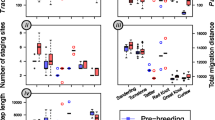Abstract
Migrating birds often alternate between flight steps, when distance is covered and energy consumed, and stopover periods, when energy reserves are restored. An alternative strategy is fly-and-forage migration, useful mainly for birds that hunt or locate their prey in flight, and thus, enables birds to combine foraging with covering migration distance. The favourability of this strategy in comparison with the traditional stopover strategy depends on costs of reduced effective travel speed and benefits of offsetting energy consumption during migration flights. Evaluating these cost-benefit effects, we predict that fly-and-forage migration is favourable under many conditions (increasing total migration speed), both as a pure strategy and in combination with stopover behaviour. We used the osprey (Pandion haliaetus) as test case for investigating the importance of this strategy during spring and autumn migration at a lake in southern Sweden. The majority, 78%, of passing ospreys behaved according to the fly-and-forage migration strategy by deviating from their migratory track to visit or forage at the lake, while 12% migrated past the lake without response, and 10% made stopovers at the lake. Foraging success of passing ospreys was almost as good as for birds on stopover. Timing of foraging demonstrated that the birds adopted a genuine fly-and-forage strategy rather than intensified foraging before and after the daily travelling period. We predict that fly-and-forage migration is widely used and important among many species besides the osprey, and the exploration of its occurrence and consequences will be a challenging task in the field of optimal migration.




Similar content being viewed by others
References
Alerstam T (1990) Ecological causes and consequences of bird orientation. Experientia 46:405–415
Alerstam T (2000) Bird migration performance on the basis of flight mechanics and trigonometry. In: Domenici P, Blake RW (eds) Biomechanics in animal behaviour. BIOS Scientific Publishers, Oxford
Alerstam T (2003) Bird migration speed. In: Berthold P, Gwinner E, Sonnenschein E (eds) Avian migration. Springer, Berlin, pp 253–267
Alerstam T, Hake M, Kjellén N (2006) Temporal and spatial patterns of repeated migratory journeys by ospreys. Anim Behav 71:555–566
Alerstam T, Lindström Å (1990) Optimal bird migration: the relative importance of time, energy and safety. In: Gwinner E (eds) Bird migration: physiology and ecophysiology. Springer, Berlin, pp 331–351
del Hoyo J, Elliott A, Sargatal J (eds) (1994) Handbook of the birds of the world. Vol 2. New World vultures to guinea fowl. Lynx Edicions, Barcelona, pp 42–51
Dorst J (1962) The migrations of birds. Windmill Press, Kingswood, Surrey
Forsman D (1999) The raptors of Europe and the Middle East—a handbook of field identification. T & AD Poyser, London, pp 21–29
Fransson T, Pettersson J (2001) Svensk ringmärkningsatlas. Vol 1. Naturhistoriska Riksmuseet, Stockholm, pp 167–173
Hake M, Kjellén N, Alerstam T (2001) Satellite tracking of Swedish ospreys Pandion haliaetus: autumn migration routes and orientation. J Avian Biol 32:47–56
Hedenström A (1993) Migration by soaring or flapping flight in birds: the relative importance of energy cost and speed. Philos Trans R Soc Lond B 342:353–361
Hedenström A, Alerstam T (1998) How fast can birds migrate? J Avian Biol 29:424–432
Kjellén N, Hake M, Alerstam T (1997) Strategies of two Ospreys Pandion haliaetus migrating between Sweden and tropical Africa as revealed by satellite tracking. J Avian Biol 28:15–23
Kjellén N, Hake M, Alerstam T (2001) Timing and speed of migration in male, female and juvenile ospreys Pandion haliaetus between Sweden and Africa as revealed by field observations, radar and satellite tracking. J Avian Biol 32:57–67
Lindström Å (2003) Fuel deposition rates in migrating birds: causes, constraints and consequences. In: Berthold P, Gwinner E, Sonnenschein E (eds) Avian migration. Springer, Berlin, pp 307–320
Martell MS, Henny CJ, Nye PE, Solensky MJ (2001) Fall migration routes, timing, and wintering sites of North American ospreys as determined by satellite telemetry. Condor 103:715–724
Österlöf S (1977) Migration, wintering areas, and site tenacity of the European osprey Pandion h. haliaetus (L.). Ornis Scand 8:61–78
Pennycuick CJ (1989) Bird Flight Performance. Oxford University Press, Oxford
Piersma T, Lindström Å (1997) Rapid reversible changes in organ size as a component of adaptive behaviour. Trends Ecol Evol 12:134–138
Piersma T, Gudmundsson G A, Lilliendahl K (1999) Rapid changes in the size of different functional organ and muscle groups during refueling in a long-distance migrating shorebird. Physiol Biochem Zool 72:405–415
Poole AF (1989) Ospreys: a natural and unnatural history. Cambridge University Press, Cambridge
Prevost YA (1982) The wintering ecology of ospreys in Senegambia. Ph.D. thesis, University of Edinburgh, Edinburgh
Rubolini D, Gardiazabal Pastor A, Pilastro A, Spina F (2002) Ecological barriers shaping fuel stores in barn swallows Hirundo rustica following the central and western Mediterranean flyways. J Avian Biol 33:15–22
Rudebeck G (1950-51) The choice of prey and modes of hunting of predatory birds with special reference to their selective effect. Oikos 2:67–88, 3:200–231
Schaub MR, Pradel L, Jenni L, Lebreton J-D (2001) Migrating birds stop over longer than thought: an improved capture-recapture analysis. Ecology 82:852–859
Strandberg R, Alerstam T, Hake M (2006) Wind-dependent foraging flight in the osprey Pandion haliaetus. Ornis Svecica 16:150–163
Acknowledgements
We are very grateful to Mikael Hake and Raymond Klaassen for encouraging discussions about osprey ecology and migration strategies. Many thanks also to Jan van Gils and an anonymous referee for very valuable and constructive comments on the manuscript. This work was financed by grants from the Swedish Research Council.
Author information
Authors and Affiliations
Corresponding author
Additional information
Communicated by W. Wiltschko
Rights and permissions
About this article
Cite this article
Strandberg, R., Alerstam, T. The strategy of fly-and-forage migration, illustrated for the osprey (Pandion haliaetus). Behav Ecol Sociobiol 61, 1865–1875 (2007). https://doi.org/10.1007/s00265-007-0426-y
Received:
Revised:
Accepted:
Published:
Issue Date:
DOI: https://doi.org/10.1007/s00265-007-0426-y




